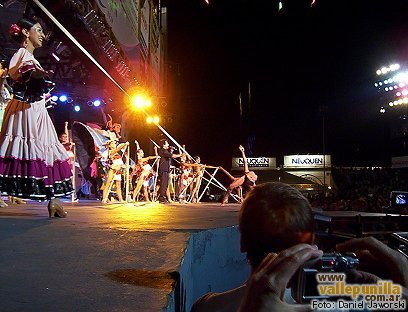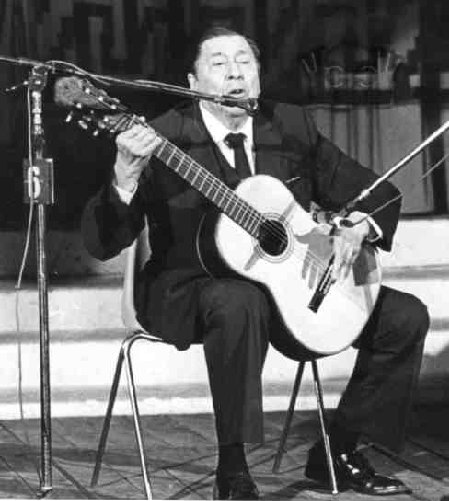I set out to find parallels in Latin American live music, with a focus on the particularly vibrant Argentinean music scene. I found numerous “festivals” in Buenos Aires that seemed to be more concert series than anything else. However, one event, a folk festival almost one thousand miles from Buenos Aires, offered a very strong sense of community, and a great deal of dedication and enthusiasm. Despite its prominence in Latin America, and especially Argentina, there is not a great deal of English scholarly work on Cosquín, nor is there much scholarly work on modern music festivals. While this made researching challenging, I enjoyed the fact that my interest in Cosquín might yield somewhat unique conclusions.
Cosquín

In 1961 residents of the Argentinean city of Cosquín, about a thousand miles from Buenos Aires, organized a festival celebrating national folklore in an attempt to reinvigorate local tourism. It took place over nine days in January, during the Argentine summer vacation season. Instant success led the Fetival Nacional del Folklore Cosquín to become an annual event and one of Latin America’s largest cultural celebrations. The festival still takes place over nine days, referred to as the nine moons of Cosquín.
Cosquín’s size and history set it apart from the majority of other Argentinean music festivals, but its attendee experience is also quite different. Most notable are the peñas- impromptu street performances- that are a constant presence throughout the streets of Cosquín. These take place during the day, as visitors walk through the exhibitions lining the streets, at night during the featured concerts, and late at night, after the featured concerts.
The performances are one of the most important features of the festival. Relatively unknown artists, as well as some artists who come off of the main stage, find an audience in the hundreds of thousands of fans that make their way through the streets of Cosquin each year. This video, featuring the less-known Leandro Romero , shows an enthusiastic and diverse crowd. (Diversity refers to age and gender diversity in this context. Argentina is one of the countries in South America with the smallest black populations.) Because of Romero’s status as a relative unknown artist, that so many are singing along leads the viewer to believe that he is performing a traditional song, and to very positive reactions from his audience.
As outside influences begin to settle in and cultural miscegenation proliferates, Cosquín has become a sort of litmus test for folk arts, and especially music. A 2008 Rolling Stone article reviewed a performance by Divididos, a popular Argentine rock band, at Cosquín. The band recognizes strong folk influences, and opened their performance at Cosquin with an acoustic set consisting of traditional folk songs. They then played a late-night electric set. At the end of it, wearing the traditional white ponchos of Cosquín, the band’s leader said “Cosquin, thank you for accepting us as we are.” (Rolling Stone)
Beyond the musical, Cosquín becomes a hub of all things endemic to Argentina. Jones describes a scene in which all of Argentina’s best artisans come to sell their works, as well as to educate both countrymen and visitors. Musical instruments, mate cups (designed for drinking the traditional Argentine tea), and other crafts are displayed and sold in a church square. The market is the National Fair of Handicrafts and Popular Art. Even beef, the country’s culinary specialty, makes a showing at massive barbacoas, back stage. (Jones)
Whereas the majority of all festivals held in Argentina seemed to be based in Buenos Aires, Cosquín located 1000 miles away. This distance may have actually played a significant role in maintaining the identity of Cosquín. Argentina’s chief musicial export is the tango, widely performed over the twentieth century (and recently revived) throughout the world. In the mid-1900’s, the blend of Peronism and conservatism, generally did not favor the tango, which was seen as vulgar and subversive. Though Peron seems to have, at different times, favored and persecuted the tango, he was ousted in the 1950’s, and the new government saw the tango, which peron had then aligned himself with, as being as bad as Peron himself. Initial years of Cosquín, those shortly after the coup, did not feature the tango very heavily. Subsequently, in 1963, a presidential decree established the third week in January the National Week of Folklore. (aquicosquin.org) Of course, over time tango became less vilified and rose to a more accurate degree of representation in the festival. (Denniston)
Cosquín features several symbols and themes with explicit ties to Argentine and Indian folklore. These serve to solidify the strong sense of representing and promoting the country’s proprietary culture. Many have distinctly anti-Spanish roots, and serve as a reminder of Argentina’s colonial past (Spanish rule ended in the early nineteenth century.)
The festival grounds feature a stage built in 2001, with seating for about 10,000 and two stages that revolve, speeding up time between acts. The stage is named for Atahualpa Yapanqui (Héctor Roberto Chavero Aramburo), perhaps Argentina’s most prominent and influential folk musician. (Jones) Aramburo’s adopted name comes from those of two Incan kings, and makes clear his populist standing (he was a communist for about 20 years, and his popularity and radio play increased greatly only when he ended his affiliation.) (Tiempos)


Every year a trophy is awarded to those who have made significant contributions to folklore. It is named for a folk hero, Casique Camin. Camin is said to have killed a Spaniard who was after his wife and died at the hands of the slain man’s compañeros. The story takes place in the immediate vicinity of the festival.
The festival has its own rallying cry, of sorts, as well as a theme or fight song. Each evening of the festival begins with a performance and interpretation of the “Himno”, followed by the cheer “Aquí Cosquín. Capital de Folklore”, with the last syllable of each of the first two words substantially elongated. Even outside of the festival, it is used as a sort of identifier. Many YouTube (as well as blog) commenters used the phrase to demonstrate that they were Cosquín attendees and fans. The “himno” performances can be seen in the following videos. They are incredibly elaborate and rich with symbolism- flags, livestock, soccer, dress of all varieties. The musical arrangements (as well as choreography) seem to mix modern musics- electric guitars and electronic sounds- with the traditional.
See also this video for another performance of the himno.
In spite of these numerous anti-colonial symbols, there are strong public and private efforts to encourage tourists to come to the festival. In fact, the majority of English-language internet search returns were tourism pages, this despite the general Latin-American sentiment (egged on by Hugo Chavez’s calls for a “second independence”) (Economist, 2009) that the United States are a colonialist threat. This demonstrates a certain confidence in the integrity of the culture.
Clearly, Cosquín is a very special experience for attendees and performers alike. Responding to the earlier posted Cosquin trailer, one Youtube commenter wrote: “It gives me good bumps… when [the main plaza] is empty you can feel the applause… it’s my dream and that of every artist to rise to that stage.” (Youtube) By elevating folk music to such a prominent stage, aspiring musicians are given even concrete motivation to pursue their music. Furthermore, in the days leading up to the official festival, Cosquin hosts “Pre-Cosquin” a showcase of rising and regional talent from throughout the country. These artists are selected at official auditions held throughout the country in the three months before the festival.
The Cosquín National Folklore Festival is an amazing microcosm of Argentine culture, aggregating and synthesizing hundreds of years and millions of people into a rich sampling of all that tradition Argentina chooses to present. Frey (1994) indirectly points out that music festivals encourage independent artistic expression because there are so few explicit expectations, and so many other acts serving as infrastructure- supporting each other. Cosquín’s massive collection of Argentinean folklore allows artists to explore their own culture with and in front of their peers. In doing so, it stokes the people’s nationalist sentiments, and gives Argentines both a symbol, something they can be proud of, and an anchor, which they can look to as their country and culture interacts with the rest of the world. It also gives would-be folk artists a stage to aspire to, and a sense of purpose and acceptance, in their pursuit of a personal interpretation of traditional Argentine folk culture.
See also:
www.aquicosquin.org
Has an amazing collection of information, pictures, etc. Go to Gallería for pictures, posters, videos, and the like.
A couple Buenos Aires Festivals: Pepsi Fest and PersonalFest. Both are corporate sponsored and pop-music focused, bringing bands from around the world.
Cosquin Rock is Cosquin's rebellious nephew. It features rock bands of all kinds, and a very different crowd and culture.
Works Cited:
"Bolívar's continent." Economist, 13 Nov. 2009. Web. 14 Nov. 2009.
"Cosquin 2009 Trailer." Cosquin 2009 Trailer. Youtube, 5 Jan. 2009. Web. 20 Oct. 2009.
Denniston, Christine. "The Dark Age of Tango." The History of Tango - 150 years of Tango Dance and Music History. History-of-Tango.com, 2003. Web. 14 Nov. 2009.
(I recognize that this is merely a website, however, I researched Denniston and she is the world's most prominent tango scholar.)
"Divididos, la aplanadora del folk." Rolling Stone, 22 Jan. 2008. Web. 12 Nov. 2009.
"El Payador Perseguido." Tiempos 30 Jan. 2005: 4-5. Print.
Florine, Jane. "EL FESTIVAL NACIONAL DE FOLKLORE Y LA BÚSQUEDA DE IDENTIDAD NACIONAL ARGENTINA." Anais do V Congresso Latinoamericano da Associação Internacional para o Estudo da Música Popular: 1-7. Print.
Frey, Bruno S. "The Economics of Music Festivals." Journal off Cultural Economics 18.1 (1994): 29-39. Print.
Jones, Dennis. "Aquiii Cosquiiin." Americas 2009: 60-63. Print.
"National Festival of Folklore." 2009. Web. 20 Oct. 2009.
I love argentinean culture, so when I went there, to an apartment in Buenos Aires, I went to Cosquin, to watch that Festival of national folklore. It was amazing. A lot of people dancing,and very cheerful!!!
ReplyDelete